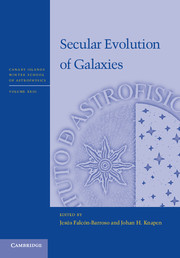Book contents
- Frontmatter
- Contents
- List of contributors
- Participants
- Preface
- Acknowledgments
- Secular evolution in disk galaxies
- Galaxy morphology
- Dynamics of secular evolution
- Bars and secular evolution in disk galaxies: Theoretical input
- Stellar populations
- Star formation rate indicators
- The evolving interstellar medium
- Evolution of star formation and gas
- Cosmological evolution of galaxies
Preface
Published online by Cambridge University Press: 05 September 2013
- Frontmatter
- Contents
- List of contributors
- Participants
- Preface
- Acknowledgments
- Secular evolution in disk galaxies
- Galaxy morphology
- Dynamics of secular evolution
- Bars and secular evolution in disk galaxies: Theoretical input
- Stellar populations
- Star formation rate indicators
- The evolving interstellar medium
- Evolution of star formation and gas
- Cosmological evolution of galaxies
Summary
The formation and evolution of galaxies are among the most important topics under study in modern astrophysics. Over the last decade in particular, with the advent of large observing facilities and surveys, galaxies have become even more prominent in our understanding of the Universe and its evolution. The detailed study of secular, or internal, evolution in galaxies describes the relatively slow evolution induced primarily by internal processes such as the actions of spiral arms, bars, ovals, galactic winds, black holes, and dark matter haloes. Secular evolution plays an important role in the evolution of spiral galaxies, with major consequences for the formation of galactic bulges, the transfer of angular momentum, or the distribution of stars, gas, and dust.
The notion of secular evolution in galaxies has been around since the late 1970s, but has recently become a major focus of astrophysical research. This is due to a number of reasons, but mostly the availability of multiple new observational tools, for instance deep near- and mid-infrared imaging from the ground and from space, high spatial resolution imaging with the Hubble Space Telescope, and two-dimensional integral-field spectroscopy of large samples of galaxies. It has also been realised that the study of internal evolution in galaxies is key to understanding the validity of cosmological models of galaxy formation and initial evolution. Such models must reproduce the main characteristics of galaxies seen at the present epoch.
- Type
- Chapter
- Information
- Secular Evolution of Galaxies , pp. xv - xviPublisher: Cambridge University PressPrint publication year: 2013

